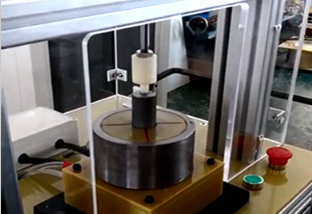What are the common mechanical failures and solutions for brushless motor motor automatic rotor magnetizer?
Brushless motor motor automatic rotor magnetizer in the operation process may appear some mechanical faults, the following for you to introduce the common faults, causes and corresponding solutions:
1、Rotor positioning and clamping failure
l Failure phenomenon
The position of the rotor is shifted in the process of magnetization, resulting in uneven magnetizing effect and affecting the performance of the motor.
Insufficient rotor clamping force may loosen or even fall off during magnetization, posing a hidden danger.
l Failure causes
Wear and tear of the parts of the positioning mechanism, such as positioning pins, positioning blocks, etc., resulting in a decrease in positioning accuracy.
Aging or damage of the cylinder, spring and other parts of the clamping mechanism, resulting in unstable clamping force.
The installation position of the positioning and clamping mechanism is changed and not adjusted in time.
l Solution
Regularly check the parts of the positioning mechanism, and replace the parts with serious wear and tear in time.
Detect the cylinder pressure or spring elasticity of the clamping device, if the cylinder leakage needs to be repaired or replaced, the spring elasticity is not enough to replace the spring.
Recalibrate the installation position of the positioning and clamping mechanism to ensure its accuracy.
2, transmission system failure
l Failure phenomenon
The drive belt of the magnetizer slips, resulting in unstable rotor speed and affecting the quality of magnetization.
The chain drive of the magnetizer has problems such as chain loosening and tooth jumping, which makes the transmission unstable.
Abnormal noise and stuttering phenomenon in gear transmission may be due to gear wear or damage.
l Failure causes
The transmission belt is loose after long-term use, or the surface of the belt is oily or worn.
The chain is not regularly tensioned, or the connecting part of the chain is loose.
Insufficient lubrication of the gears, impurities, or insufficient manufacturing precision of the gears themselves, which increases wear after a long period of use.
l Solution
Adjust the tension of the drive belt, replace the belt with a new one if it is seriously worn, and clean the oil on the surface of the belt.
Regularly check the tension of the chain, timely tensioning operation, tighten the chain connection parts.
Clean and lubricate the gears, add appropriate lubricants, if the gears are badly worn, replace the gears.

3、Loosening and deformation of mechanical structure
l Fault phenomenon
In the process of operation, the overall vibration of the magnetizer increases, and is accompanied by abnormal noise.
The relative positions of some mechanical parts change, affecting the normal work of the magnetizer.
l Cause
During the long-term operation of the equipment, the bolts, nuts and other connecting parts are loosened due to vibration and other reasons.
The mechanical structure is hit by external forces or subjected to large stress for a long time and deformation occurs.
l Solution
Regularly check and tighten all the bolts, nuts and other connecting parts on the magnetizer to prevent loosening.
For mechanical parts that have been deformed, repair or replace them to ensure the stability and precision of the mechanical structure.
4、Failure of guide rail and slider
l Fault phenomenon
Slider sliding on the guide rail is not smooth, jamming, crawling phenomenon.
The gap between the guide rail and the slider increases, resulting in a decline in motion accuracy.
l Failure causes
Dust, iron filings and other impurities on the surface of the guide rail and the slider block the normal sliding of the slider.
Insufficient lubrication of the guide rail and the slider, increasing friction.
After long-term use, the guide rail and the slider are worn, and the gap becomes larger.
l Solution
Regularly clean the impurities on the surface of the guide rail and the slider, which can be cleaned with compressed air or cleaner.
Add lubricant to the guide and slider in accordance with the specified lubrication period and lubrication method.
If the guide rail and slider wear is serious, you can adjust the gap or replace the worn parts to restore its movement accuracy.
5. Fixed fault of electromagnetic coil
l Fault phenomenon
The electromagnetic coil is displaced during the working process, resulting in uneven distribution of magnetic field and affecting the magnetizing effect.
Loose fixing bolts of the electromagnetic coil may cause collision between the coil and other parts, damaging the coil.
l Cause of Failure
The fixing bolts of the electromagnetic coil are loosened due to vibration of the equipment.
The bracket for fixing the solenoid coil is not designed properly or is not strong enough, and is deformed after long-term use.
Solution
Regularly check the fixing bolts of the solenoid coil and tighten the loose bolts in time.
Evaluate the bracket for fixing the solenoid coil, and reinforce or replace it if it is not strong enough to ensure stable fixing of the solenoid coil.
※ If you still can not solve the problem by the above ways and means, please contact the technical specialist of Xinhui Electromechanical Equipment Co.







